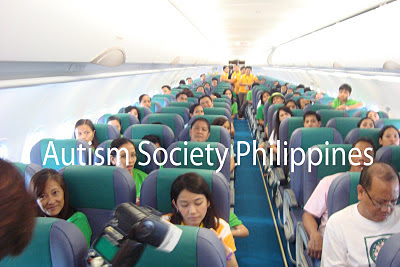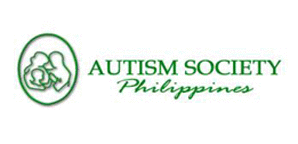By DANG U. KOE, ASP Chair Emeritus
MANILA, Philippines — If you will notice before we get inside this plane, this aircraft is smiling and we are all smiling because we want everybody to be happy while inside the aircraft”.
Thirty-two students with autism from GS Option House for Autism and Learning Center recently enjoyed a virtual plane ride inside Cebu Pacific Air’s newly delivered A-320.
Cebu Pacific Air, one of the country’s leading domestic carriers, partnered with Autism Society Philippines (ASP) to launch project “Dream on Flight” as part of the airline’s advocacy program.
Most of the invited students with autism have not yet experienced riding in a plane. It was essential to prepare them a week before the fieldtrip. A thorough assessment of the students’ deficits during travel to a new place was done.
Concerns like adaptability, sensory issues, difficult behavior, dysfunctions or limitations, non-compliance, inappropriate behavior, and resistance to change were considered. The planned activity was also incorporated in the students’ Individualized programs and simulated in school.
 |
| (L-R) Michael Shau, Ging Viado, Candice Iyog, Michelle Eve De Guzman |
Our Angel Talker this week is
Noemi “Ging” Viado, founder of
GS Option House for Autism and Learning Center in Biñan, Laguna. As a special educator for the past two decades, she has been conducting lectures to parents and professionals.
Her center offers special education and inclusive program for persons with autism. Teacher Ging also serves her second third term as board trustee of ASP. Angels Talk also acknowledges the help of Autism Angels
Tiffany Tan and
Catherine Espenilla Genovia on this issue.
*****
1. How did GS Option House prepare the children for the fieldtrip?
The following approaches and strategies were applied to address students’ challenging or inappropriate behaviors:
a) Warning and prediction of events (including rules) by using “what to do chart” in the airplane and airport; giving social stories and contract agreement among able and high functioning children with autism.
b) Familiarization of the place through visual presentations and written cues.
c) Simulation or desensitization for those children who have auditory and space problem;
d) Repetitive rehearsals of falling in line, sitting, waiting and being quiet in public places;
e) Relaxation techniques such as massage, breathing exercises and holding the children’s hands when they get afraid;
f) Reward system (using tangible and non-tangible items that are interesting to the child) for compliance.
2. Is it important to have a companion travel with them in the virtual plane ride?
A companion is necessary to help a student with autism fit in better and cope in a new situation. To be an effective companion, one should be educated about autism since he serves as model (e.g. teacher, prompter, assistant or guide).
The companion should also be confident to implement and connect strategies in handling inappropriate behaviors. The most important role of a companion is to encourage and be non-threatening to the student with autism. This will make it easier for the students to learn how to cope in new public places.
The school trained, oriented, and collaborated with all the companions on what to do during the special trip. For this trip, the 32 students each had a companion, and were supported by six trained special educators.
 |
| A TOTAL of 32 students with autism from GS Option House for Autism and Learning Center enjoy a virtual plane ride through Autism Society Philippines’ Dream on Flight project in partnership with Cebu Pacific. |
3. Were the rules on plane discussed with the children?
Before the planned field trip, a discussion between the organizer and our GS Option team was conducted, together with Cebu Pacific coordinators, facilitators and crew. The purpose of the trip, the expectation of each group and the trip guidelines were discussed. Cebu Pacific provided us with clear procedures which we discussed with teachers, students and their companions upon arrival and before boarding the aircraft.
The friendly and accommodating aircraft staff transformed themselves into “teachers” as they assist our students to follow the rules. “For this day, I will be your teacher,” said cabin crew supervisor
Melody Mercado. Flight attendants
Gelyn Tensuan,
Paula Pacres and
Jay Malinis served as “Teacher Melody’s co-teachers”. The procedures and orientation were structured and precise for us to feel comfortable and manageable.
The crew did actual demonstration of what to do inside the aircraft. It included using the seatbelt, mask and vest in case of emergency. Other aircraft personnel participated in the familiarization and discussion of the parts of the aircraft and its uses.
“Sana lilipad kami!” or “Can we fly?” were the comments from the companions as well as the students. “Birds use their wings to fly in the sky. Though airplanes have wings, the wings don’t flap like birds do,” said
Captain Raffy Locson. He also explained to the children how pilots fly planes.
After the lectures, Capt. Locson joined the cabin crew in a short talent show — six children with autism and care givers rendered a song and dance number. But the most exciting part of the show is the dancing pilot and cabin crew!
The talent show motivated the children; the crew and companions appreciated their numbers which boosted their morale. Opportunities to show off their talents add to their self-worth knowing they have somehow created an impact to others. This activity also sustained their focus; their sitting and waiting time were more tolerable, as they were themselves entertained.
4. What made this fieldtrip a success?
The 2.5 hour journey for Dream a Flight was very successful. The evidence was shown clearly through their good behavior throughout the entire program; with one exception — one boy cried and covered his ears, but this was managed immediately.
I truly believe that it was because of the concerted effort of ASP, the Cebu Pacific management, staff and crew, as well as the GS Option Staff, companions and the children themselves who were all prepared for the activity.
The staff of Cebu Pacific Air was committed to achieve our goals for the students. We arrived an hour earlier for the event, but knowing that children with autism have difficulty waiting, the staff started the program right away!
It’s wonderful to know that the crew that assisted us were all volunteers. Instead of taking their off-duty time, they volunteered to support us.
I remembered during one of my Cebu Pacific flights with my daughter Gigi, we were privileged to choose our seats on the plane. We were even escorted to the VIP room and were first to be boarded on the plane.
I have high hopes that all other airlines will extend the same courtesy to persons with autism and other disabilities. As mandated in Republic Act 9442, PWDs are given priorities during boarding and deplaning, and their special needs should be accommodated. Not to mention of course the 20 percent discount. Just don’t forget to bring valid IDs.
We want to commend Cebu Pacific Air and other airlines that will offer opportunities for simulation activities for children with autism prior to their actual flights. It will really help them experience a wonderful Dream on Flight.
Uploaded with permission Acknowledgment Manila Bulletin: Autism angels fly!







0 comments:
Post a Comment